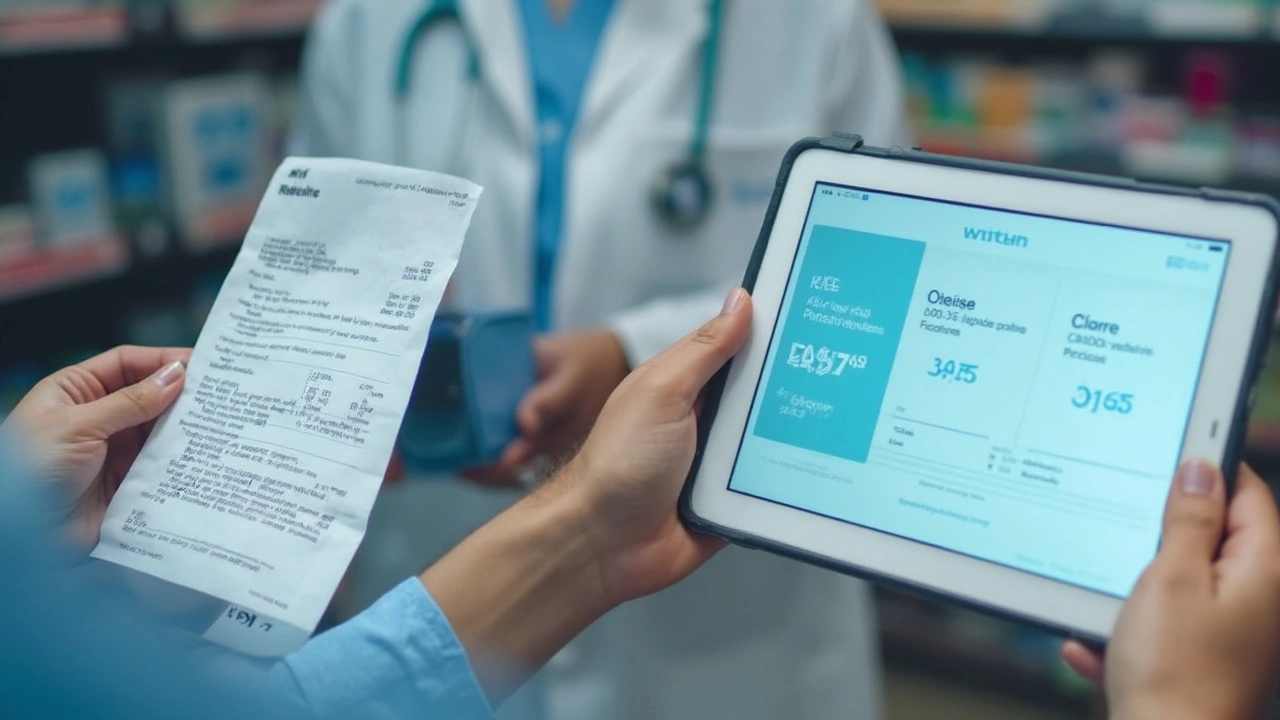If you’ve ever gritted your teeth over a long wait at the pharmacy counter—wondering if you’re paying extra just for the thrill of standing in line—you’re not alone. The way we buy medications is quietly changing. Online players like ZipHealth run on a no-storefront, ship-to-you model that claims to save you both time and money. But does the online promise of 'lower costs' actually stack up against your local drugstore’s sale flyers, discount cards, and familiar faces? Buckle up, we’re taking the guesswork out of prescription buying, breaking down the real dollars, cents, and everything sneaky that goes into the price tag.
The Price Tag: What Are You Really Paying For?
Let’s talk about sticker shock. Most of us look at the pharmacy receipt and only see the bottom line. But there’s a whole iceberg lurking underneath: insurance negotiations, generic vs. brand pricing, dispensing fees, and the not-so-obvious overhead of keeping hundreds of stores running lights-out every night. Online pharmacies, especially ZipHealth, work differently. They cut out storefront overhead, skip the crowded aisles, and pass on certain savings—on paper. Still, you’re probably wondering: how much does that actually change your wallet?
Here’s where it gets interesting. Typical brick-and-mortar pharmacies, like CVS or Walgreens, add several dollars per prescription just to cover labor and rent. According to Consumer Reports’ 2023 survey, cash prices for a 30-day supply of atorvastatin (a common cholesterol med) averaged $13 at major U.S. chains—but just $6-$10 online. That’s nearly a 30% cut. For antibiotics (say, amoxicillin), the in-store price is closer to $20 while online comes in around $8-$11.
But hold up—don't forget about insurance. Many insurance plans cut deals with pharmacies to lower your out-of-pocket costs, and sometimes drive copays below any online price. On the flip side, online services like ZipHealth often target the uninsured or underinsured, focusing on generic meds where insurance discounts don’t matter. In other words, your savings depend on your insurance status and the meds you need. Without a plan? ZipHealth’s flat-rate pricing starts to look very compelling.
You might also catch special coupon programs at brick-and-mortar stores (think GoodRx or pharmacy club cards). But these deals can be a maze—valid only for specific drugs, or at select stores. Online pharmacies usually skip the coupon circus and bake their discounts into straightforward pricing tables.
| Medication | 30-Day Supply (ZipHealth/Online) | 30-Day Supply (Chain Drugstore) |
|---|---|---|
| Amoxicillin | $10 | $20 |
| Atorvastatin | $8 | $13 |
| Levothyroxine | $6 | $11 |
| Sildenafil | $19 | $28 |
Most people don’t realize shipping is almost always free with these online options. That’s a real hidden cost buster: you’re not paying for gas, parking, or that overpriced soda you grudgingly grabbed at checkout.
The Online Edge: What Makes ZipHealth Different from the Corner Pharmacy?
If you’ve never tried an online pharmacy, the idea might sound a little risky. Prescriptions mailed to your door? Is it even safe? Here’s the straight scoop—ZipHealth (and other licensed online pharmacies) have to follow the same pharmacy regulations as local stores. They need verified U.S.-licensed pharmacists, HIPAA-compliant systems, and, yes, real prescriptions from doctors.
The biggest game-changer with ZipHealth is speed and simplicity. You fill out a quick online questionnaire, upload or transfer your script, and let them handle the legwork. Usually, there’s no need to call your doctor’s office or haggle on the phone. For routine generics, refills are nearly automatic.
Traditional pharmacies can’t match this hassle-free experience. Ever tried getting a rapid refill at 8:05 after a workday? Most chains close early, and smaller ones may keep even shorter hours. With online pharmacies, you can do everything—order, chat with a pharmacist, track your meds—without clock-watching. Surveys by the National Association of Boards of Pharmacy show patient satisfaction with online refills is surging, citing reduced wait times and fewer lost prescriptions as top perks.
Of course, ZipHealth’s automation comes with some trade-offs. In-person advice from a pharmacist is missing; you’ll chat or email instead. For complicated medication regimens or first-time users, personal touch might still matter. But for most people on common, well-understood drugs, that in-person consult becomes more of a nice-to-have than a need-to-pay-for service.
Another cool thing? ZipHealth (and similar sites) frequently cover a wider range of lifestyle and sensitive treatments—things like hair loss, sexual health, and acne meds—where privacy is a real draw. No embarrassing face-to-face, just discreet packaging sent directly to your mailbox.

Hidden Fees and Caveats: Watch Where Your Dollars Go
Nothing’s ever totally straightforward on either side. Online and traditional pharmacies both have fine print that’s easy to overlook—and it all affects your total bill.
- Shipping & Delivery: Most online sites say 'free shipping,' but sometimes only above a minimum order, or only for select meds. Be careful—overnight or expedited shipping can cost extra. Still, for basic generics, most orders from ZipHealth qualify for free regular delivery.
- Consultation Fees: Some online services bundle a 'doctor’s consult' into the price—great for people without a primary doc, but not helpful if you already have a script. At ZipHealth, many treatments include this, but only for certain categories. Always read the pricing page.
- Pharmacy Fee Madness: Brick-and-mortar places sometimes slip in refill processing charges or tiers for 'preferred' customers. Also, look out for those $5-$15 “convenience fees” buried in your bill if you don’t use insurance or if you need a rush order at the counter.
- Insurance Gotchas: Your insurance plan might partner with big chains and reject online options entirely. It pays to check if meds ordered from ZipHealth will count for your deductible or medical spending, especially for FSA/HSA funds.
- Price Transparency: With traditional stores, pricing can be a mystery until you show up at the counter. Online, you see the flat fee up front—no hidden surprises.
Your best move? Always compare your insurance copay at brick-and-mortar locations with ZipHealth’s posted cash price. Sometimes, online is cheaper even if you have insurance, especially for generics. But if your plan scores deep discounts, don’t overpay out of habit. There’s no loyalty bonus for being the pharmacy’s best customer—unless you count that free reusable tote bag.
If you’re a savvy shopper (and who isn’t?), bookmark sites with price calculators before you switch. Try both options with a cheap med first to see how long shipping takes and if customer service matches up. Most people are surprised how smooth the online experience can be, especially when avoiding the usual pharmacy runaround.
Making the Right Choice: Takeaways and Useful Resources
So, who wins: ZipHealth or the local drugstore down the block? Honestly—it depends. Cash-paying customers, folks with spotty insurance, or anyone juggling a chaotic schedule tend to save more and stress less by going online. For infrequent prescriptions or meds your insurance loves to subsidize, the local pharmacy might sneak back into the lead. Doing the math—in writing—before your next refill pays off more than just hoping for savings at the checkout.
Keep an eye out for price updates. Pharmacies change charges quarterly, and special deals pop up constantly in both worlds. Watch for expiration dates on discounts—run the numbers at least once a year to avoid price creep, especially on long-term meds.
If you want to explore options beyond ZipHealth—or maybe compare what ZipHealth is doing right versus up-and-coming competitors—check out this detailed review of online pharmacy leaders at ZipHealth.co. It’s loaded with honest breakdowns, so you can weigh all your possibilities without the sales pitch.
Key tip: always vet pharmacy credentials before buying online. Stick to licensed U.S. pharmacies, look for VIPPS accreditation, and double-check customer reviews. If any price seems too good to be true, hit pause and poke around for red flags or hidden terms.
In the next couple years, expect this showdown to get even more competitive. With pharmacy chains adding mail-order wings and tech companies expanding into health delivery, your choices (and the savings) will only keep growing. The bottom line? Don’t just do what you’ve always done. Click around, ask for line-item costs, and keep your prescription routine working for you, not the other way around.
By the way, nothing beats the feeling of not having to set foot in a pharmacy—especially if you’re fighting allergies, an ear infection, or just plain annoyed at expired coupons. Nobody needs more stress at the end of a long day, and these days, you’ve got better options than ever.

